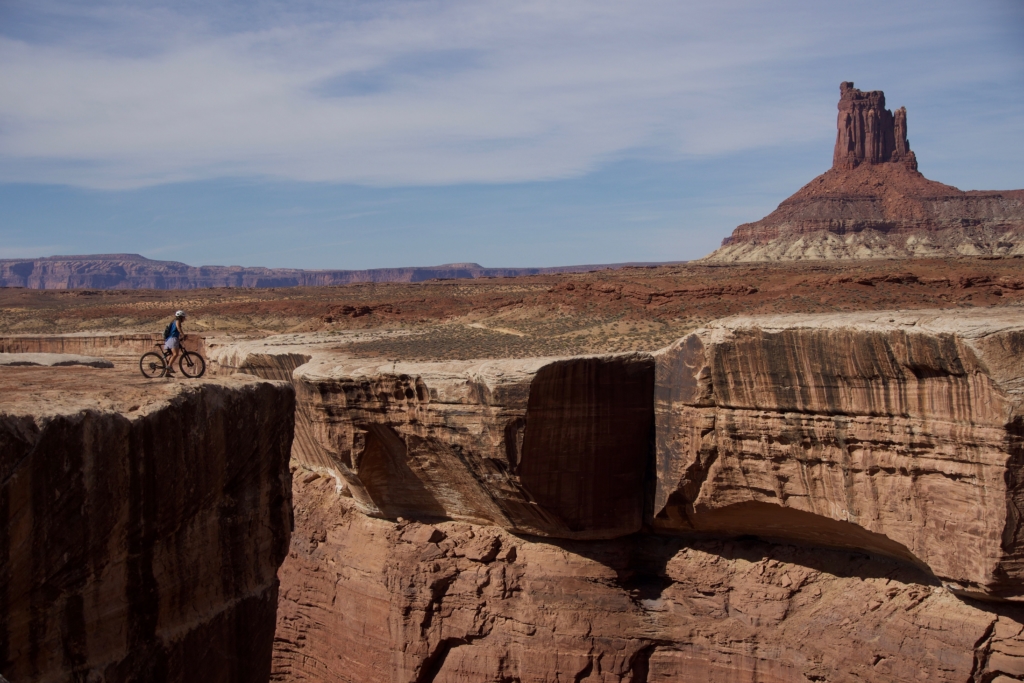
This story appeared originally in The Washington Post
Shafer Canyon Road rises from the Utah desert like a coiled snake, six switchbacks and 1,200 vertical feet of sandy, sunbaked malice poised between us and lunch, beers and one final killer view.
I’m with 12 old friends from the University of Colorado at Boulder, all in our mid-50s, and two guides, in the home stretch of a four-day, mid-October mountain bike and camping trip along the White Rim Road in Canyonlands National Park. We are tackling 80 miles of the 103-mile loop, which wends through the hypnotic scenery of these Ancestral Puebloan lands. Shafer Canyon — one of only three roads in or out of here — is our final hurdle.
We started planning this last fall and, once covid-19 hit, thought we might have to cancel. But our outfitter, Western Spirit Cycling Adventures, determined that these outdoor trips posed low risk (the company says it has had no coronavirus cases among its customers). As a precaution, we all got tested just before the trip and many of us again after returning home, with no covid detected. And, per the company’s policies, we wore masks during the shuttle rides to and from the White Rim. About half our group flew in from the coasts, with the rest driving from various points in the West.AD
For most of us, this trip ranks as a moderate challenge: The White Rim is a Jeep road, with only a few sections that a mountain biker would consider technical and perhaps a half-dozen lung-busting climbs. We are also tailed by a one-ton cherry-red Ford F-350 carrying our camping gear, clothes, food, adult beverages and, of course, wigs (more on that later). And we’re taking our time. Many people ride this circuit — without truck support — in three days, some in two and a select few in a blink. A week before our arrival, Tour de France veteran Peter Stetina set the White Rim record of 5:28:23.
Still, we’re out here, with no option to bail between start and finish. The three riders who were most concerned about keeping up rented e-bikes, which have small, battery-powered motors to provide an assist on hills. Most remarkably, we are pulling off a group trip in the middle of a pandemic, and as we gather for outdoor beers after arriving in the bustling adventure-cum-tourist town of Moab, the collective relief that this is actually happening is as palpable as the excitement of heading into the desert.
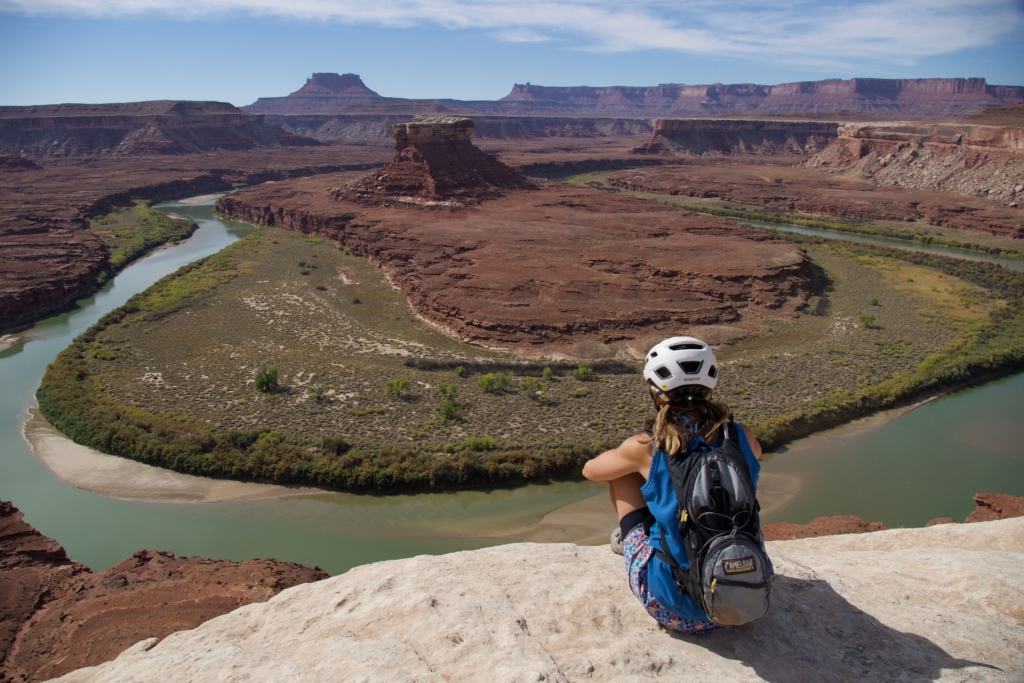
With bags and bikes atop the truck and a shuttle van, we roll out of Moab under a cloudless sky, arriving an hour later at the top of Mineral Bottom Road — 4,900 feet above sea level on the sagebrush-dotted roof of Canyonlands’ Island in the Sky district, a 132,438-acre mesa hemmed by the Colorado and Green rivers.AD
After a quick briefing, we are on our steeds, rocketing down through the geologic stack — from golden-hued Navajo sandstone and burnt-red Wingate formation, faint-green Chinle rock and, finally, 1½ miles and 900 vertical feet below our start, onto the auburn ledge of the 245-million-year-old Moenkopi layer. We skid to a stop within sight of the Green River and the incongruously bright hues of the cottonwood leaves and brush along its shores.
The mood in Hour 1 is ebullient. Terri Sofarelli, a physician assistant from Salt Lake City, and Peter Isaacson, a tech marketing executive from San Francisco, are so fired up they ride a quarter-mile back up Mineral Bottom for another taste of the downhill. We also encounter another guided group, steeling themselves for the uphill, but no surprise there: The White Rim secret has been out for decades.
The road, built in the 1950s for uranium exploration, was already gaining notice among Jeep drivers when, in May 1983, Moab local Buzz Burrell pedaled the loop (in under 12 hours) on a steel-frame Ritchey mountain bike, and a bucket-list ride was born.AD
Behind guide Tina Liss, a 26-year-old shredder from Marquette, Mich., we follow the river as it glides — silent, glassy, tantalizing — through the furnace of rock. The temperature has hit the mid-80s, and the desert is squeezing hydration from our bodies.
Twelve miles into our 16-mile day, we come to Hardscrabble, a two-tiered sustained ascent featuring sand bogs in the middle and at the end.
“Unless you’re superhuman, you aren’t making this hill,” Tina tells us. “So walk where you need to, and we’ll meet you at the top.” She’s hanging back to help her co-guide, a 29-year-old Brit named Adam Rosenfeld, navigate the truck through the sand traps.
Turns out none of us is superhuman, although Terri and Robert Abbe, a San Francisco investment banker, fake it pretty well. We’re loitering up top when we see, rising from behind a knuckle of rock, the telltale dust cloud of our truck spinning its wheels.AD
We are discussing riding back down to help when the truck lurches into view. Minutes later, Adam and Tina assemble the roadside cafe — a long folding table with a buffet line of plates, cutlery and food, along with a cooler of drinks, low-riding wood-and-canvas chairs and a hand-washing station.
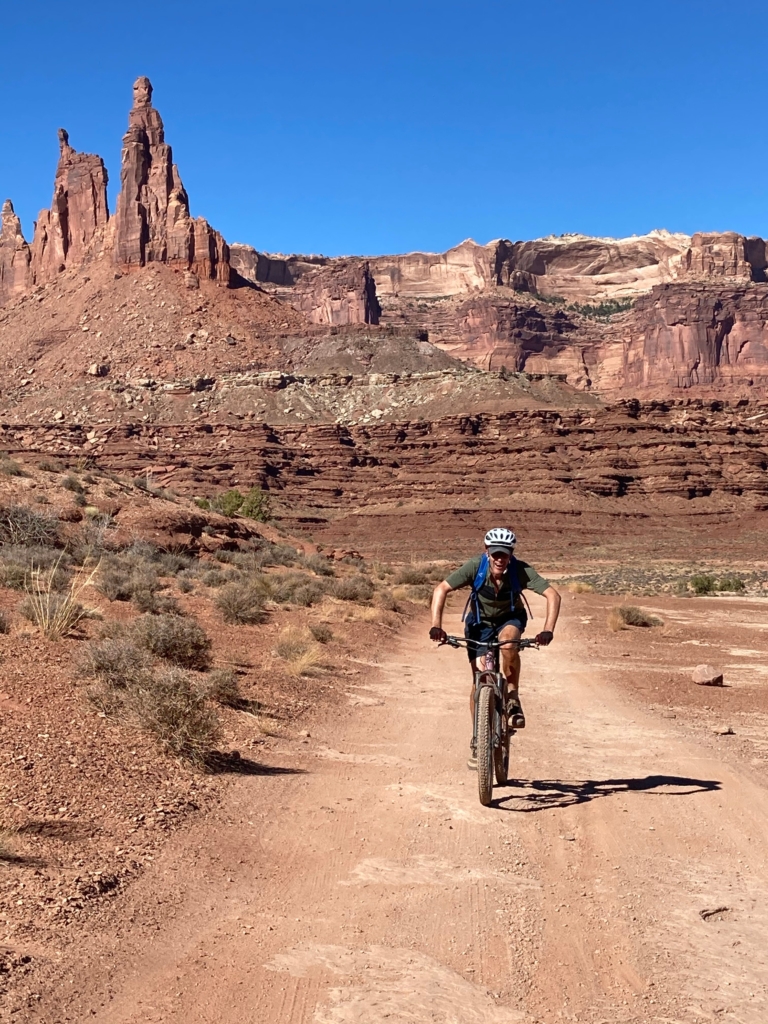
As the guides make lunch, the rest of us follow a path to a commanding view of the river as it meanders beneath the hulking sculpture of the high desert. House-size boulders balance precariously atop bony spires, surrounded by prehistoric rubble. The vibe of canyon country is distinct from anything in nature, a feeling at once humbling, boggling, meditative and affirming.
After lunch (sandwiches, salad, chips), we blast two miles down to our first camp, Potato Bottom, and pitch tents amid the tamarisk, black brush, cliff rose and a lone cottonwood, the only lick of shade we’ll have in the three camps. There’s an outhouse nearby, but no running water or other modern trappings. Because of covid precautions, most of us are in single tents, save for the two married couples among us and two women who opt to share.AD
With a couple of hours until dinner, we follow a sand path to the Green River. It’s running wide and gentle — the Green, like the Colorado, is taxed heavily upstream for irrigation, plus it hasn’t rained here since July — and we wade into the bracing water to scrub away the trail dust.
We must be having a good time because when a silver canoe drifts into view, its occupants, a 60ish couple, have only one question: If we camp near here, will you keep us up all night?
Fair enough. People come here for peace and quiet, plus we have already drawn a reprimand from the guides for firing up a small Bluetooth speaker (Grateful Dead, of course) in violation of a Park Service rule intended to preserve the soundscape of remote areas.
Don’t tell my Deadhead friends, but I favor that rule and the whole off-gridness of this trip. We had lost cell reception on the drive in, and I have not missed it for a second. As Western Spirit co-owner Ashley Korenblat tells me later, fully untethering “frees your brain up to think instead of lurching from crisis to crisis.”AD
We are about as far from crisis as one can get, washed in a golden sunset and the first pulse of a front that will deliver a series of crystalline days, with highs around 70. Over a dinner of ratatouille and pork tenderloin, I ask Adam about Western Spirit’s typical clientele.
“Pretty much this,” he says. “People my age don’t have the disposable income for a guided trip, and people much older than you-all usually won’t take it on,” although the company has guided kids as young as 9 and adults in their late 70s on the White Rim.
The next morning, after coffee and breakfast, we pack up camp and gather for our daily map meeting.
“Today,” Adam informs us, “is trending uphill,” with 23 miles and three stout climbs, a revelation that draws an apprehensive look from Barbara Colombo, a photographer and garden designer from Boulder, Colo., who barely trained for this trip. “When you pass me, shout some encouragement,” she tells me. “It actually helps.”
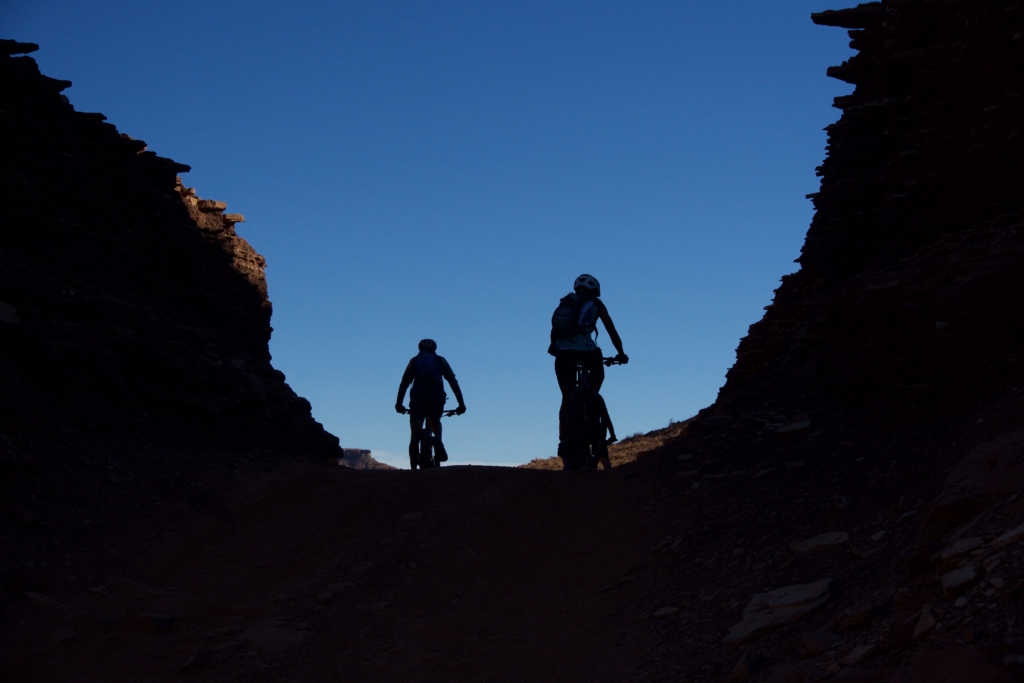
We ride out as a pack at 9:30 a.m. but soon disperse, becoming a kind of mobile cocktail party, with riders advancing or falling back to catch up with old friends and pause for photo ops. The relaxed pace is among the features of a trip like this, which Western Spirit classifies as “introductory/intermediate”; the company also offers full-bore sufferfests, including one in which much of the riding occurs on single-track trail above 10,000 feet. After a couple of hours of gradual ascending, the guides stop us for lunch next to a massive plate of buckling slick rock.AD
“Come on,” Adam says as he leads us on foot to a long fissure three to four feet wide and 65 feet deep, probably started in dinosaur times by freeze-thaw cycles and pried further open by the intervening millennia. A few hundred feet later, the shelf ends at a soaring overlook of the river as it curves, moatlike, around a citadel of 250-million-year-old rock capped by a prominent chunk of white rim.
It would be the ideal place to kill a couple of hours, but we’ve got hills to climb. I punch over the first — with a victorious howl that I’m now certain obliterated the soundscape — and into a swooping downhill beneath chestnut-hued chimneys and ramparts. The second features a double-ledge move that forces everyone but Adam off their bikes. And the third is a grinding, four-mile ascent culminating in a steep heartbreaker — pedal too fast and you spin out, too slow and you stall — that only Terri and Adam clean.
Our reward is camp, a garden of boulders, juniper, rabbit brush and shadscale across from a mezzanine overlooking a colossal basin of canyons and plateaus, ripples and folds, castles and kingdoms. Over beers and bourbon, we read poems — Lucy Lerner, a film festival manager from Telluride, Colo., had asked us each to bring a favorite — as sunbeams and shadows cede to the dazzle of Jupiter, Saturn, Mars and the Milky Way in a moonless sky.AD
The next night, after a rollicking, 27-mile day of trending downhill through primeval stadiums of hoodoos, arches and knee-buckling cliffs, the wigs come out. Terri had packed them, and we ramp up our final-night party in shiny manes of white, hot pink, psychedelic rainbow and even a green Marge Simpson.
I’m still smiling about it the following morning when we glide past four juvenile bighorn sheep that have pinned themselves between the road and a cliff. Before the final push up Shafer Canyon, I ride ahead, into a silence broken only by the whoosh of a raven overhead. She is flying uphill, toward the belly of the serpent, making it look easy.
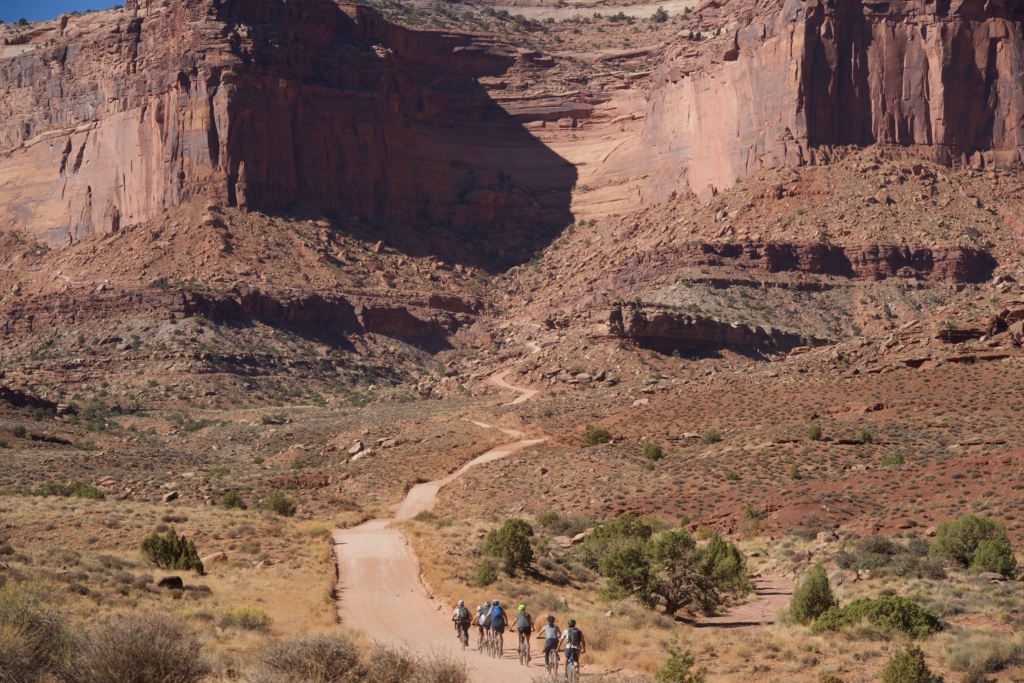
Comments